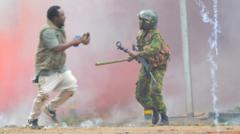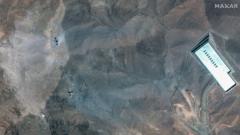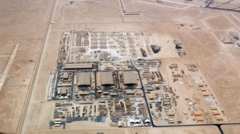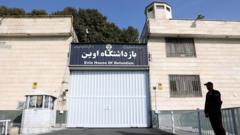In a groundbreaking first for military confrontations, India and Pakistan have engaged in targeted drone warfare, a significant deviation from their traditional combat strategies, raising fears of potential escalation.**
Drone Warfare Emerges as New Frontier in India-Pakistan Tensions**
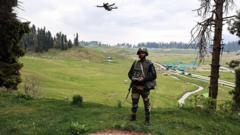
Drone Warfare Emerges as New Frontier in India-Pakistan Tensions**
The escalation of drone strikes marks a pivotal shift in the longstanding conflict between India and Pakistan.**
The ongoing aggression between two nuclear-armed nations, India and Pakistan, has taken a transformative turn with the introduction of drone warfare. As the first drone war unfolds in South Asia, tensions have escalated sharply in regions such as Jammu and Kashmir.
On Thursday, India publicly accused Pakistan of executing drone and missile strikes against three of its military installations, a charge that Pakistan denied vehemently. Islamabad, in response, claimed to have intercepted and shot down 25 Indian drones across its territory. In this escalating tit-for-tat scenario, analysts contend that such unmanned aerial attacks represent a perilous new chapter in a decades-long rivalry.
Experts warn that the introduction of drones—capable of silent, remote strikes—raises the stakes of conflict in this volatile region. Jahara Matisek from the US Naval War College stresses that the current phase of the Indo-Pak conflict could hinge on which side better masters drone warfare, potentially reshaping future battlefield dynamics.
Reports indicate that India’s military response to provocations emerged after Indian airstrikes led to significant casualties in Pakistani-administered Kashmir. The Indian government insists these operations are retaliatory, linking them to militant attacks in the region, which Pakistan disclaims any involvement in.
The drone capabilities of both nations are notable: India's arsenal features advanced systems including the Israeli-made Harop and Heron UAVs, designed for comprehensive surveillance and precision strikes. Meanwhile, Pakistan's drone fleet, believed to contain over a thousand models, leverages advanced technology from both domestic and international sources, including Chinese and Turkish systems.
While both countries demonstrate technology adapting to modern warfare, experts clarify that the current conflicts remain symbolic rather than fully encompassing the depth of modern aerial combat seen in conflicts like Ukraine. Manoj Joshi, an Indian defense analyst, remarks that while deploying drones signals a restrained military option, it also raises concerns over future escalations.
As both Indian and Pakistani militaries integrate drones into their strategies, the implications of this warfare philosophy become paramount. While these uncrewed aerial systems offer new methods to conduct operations with less immediate risk, they also promise to complicate the geopolitical landscape, creating potential for miscalculations and escalations that could outstrip the current state of hostilities.
With the situation rapidly evolving, the region stands at a precarious balance, intertwined in a delicate dance of military innovation and escalating tensions. Decisions made in the coming weeks could prove critical, determining whether this new mode of warfare leads towards restraint or further conflict between two historically adversarial nations.


